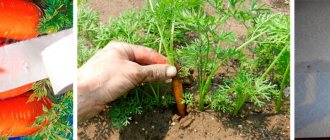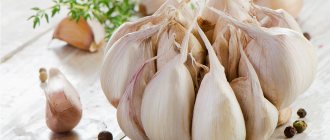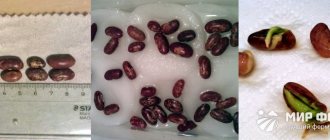Why do you need winter sowing?
Compared to spring planting, winter sowing allows you to get the harvest several weeks earlier. As soon as the snow begins to melt, seeds planted in the fall immediately begin to grow.
Seeds that spent the whole winter in the soil:
- have strong immunity;
- withstand short-term frosts down to -3 degrees;
- resistant to pests and diseases;
- are not attacked by carrot flies and cruciferous flea beetles, which are still sleeping at this time.
Preparing the soil for crops
For winter crops, the soil should be light and rich in nutrients. If you are developing a site that is new to you, it is better to try winter sowing in only one bed, leaving the rest for green manure.
Preparation of the beds takes place in September. A flat cutter or a hand cultivator are used as tools for loosening the soil. To achieve the best effect, it is better to scatter compost or humus, and then begin to loosen the soil.
If the autumn turns out to be dry, then it would not be a bad idea to water the garden bed in order to awaken the weeds, which during loosening will be cut, ground and become fertilizer during the winter.
Before planting, make grooves 1-4cm deep, and in the case of leeks 10-15cm. You can prepare compost or soil mixture in advance and keep it in a warm place until planting.
Timing of winter sowing
There are no exact dates for winter sowing. You can plant seeds at a temperature of 0 degrees, the main thing is to follow the following rules:
- the top layer of soil should be frozen;
- Carefully monitor the weather forecast; it is very important that after planting the seeds no warming is expected, otherwise they may germinate and die when cold weather arrives.
Preparing and sowing seeds (video)
At this time, the seeds are a little easier. They don’t need to be soaked to speed up the sprouts’ hatching, because in the fall we don’t need this at all.
Some gardeners use tapes or clay capsules when planting seeds, which can provide good protection against rodents.
As for the tape, it's a matter of taste. Not everyone wants to mess with it. But there’s no fuss with the capsules – I’m planted and calm.
As for the number of seeds sown, there are many opinions on this matter. It is believed that in the fall it is better to increase their number by a third or half. However, with friendly shoots, plants can interfere with each other. Therefore, it is easier to leave the number of seeds the same.
Each plant has its own depth of depth. Carrots and lettuce can be planted to a depth of up to one and a half centimeters, dill and chives up to two, beets and leaf parsley up to two and a half. Spinach can be sown to a depth of three centimeters, and onion sets up to four centimeters, provided that the size of the onions does not exceed one centimeter.
A separate conversation about leeks. They dig a ten-centimeter trench for it, but only dig in two centimeters. The remaining depth is covered with mulch, which will need to be removed in the spring to warm the soil faster. Next, you will need to add soil as the onions grow.
Celery has such small seeds that it makes no sense to dig them into the ground. You can only lightly sprinkle with peat or compost or even snow. If you cover the seeds too much, they may not germinate.
You can sow radishes in rows or don’t bother and just scatter the seeds in the garden bed and then cover them with soil or compost.
If you did not have time to carry out pre-winter plantings before the first snow, then you have not lost anything yet. The snow can be removed and the seeds can be planted, covering them with peat, compost or soil. Such seeds should also germinate successfully in the spring.
The order of winter sowing
Beds for winter crops must be prepared in advance.
Choosing a place:
- if possible, the planting site should be located on a hill so that with the arrival of spring the soil dries out faster and warms up well;
- Areas where the snow does not melt for a long time in the spring and where water stagnates are not suitable.
Setting the stage
Dig up the soil and apply fertilizers, organic or phosphorus-potassium, it's up to you. The main thing is to fertilize the soil well so that it is fertile and light.
Preparing the grooves
Make grooves 3-5 cm deep in the bed, cover them with leaves, boards or other covering material to protect them from erosion.
Sow the seeds
Sow the seeds thickly, 2 times more than when planting in spring. It is also important that they are dry.
Fall asleep the seeds
Cover the seeds with dry soil or purchased soil in a layer of about 2 cm, and lay a 2-3 cm layer of mulch on top. In spring, mulch prevents the appearance of a crust on the surface of the soil and also protects plant roots from sudden temperature changes.
Making a shelter
At the end, cover the bed with dry leaves or spruce branches so that the thickness of the cover is 15-20 cm.
How to sow vegetables before winter
To get early vegetable production, you need to know simple rules for planting crops before winter.
Selecting a location
Suitable areas are well-lit by the sun, without stagnant water, without slopes. Good drainage and fertile soil are required.
It is advisable that the beds be protected from cold winds by a fence, fences, trees or outbuildings. On sand, the height of the beds is up to 20 cm; on other types of soil, 12-15 cm is enough.
It is necessary to choose places where snow does not accumulate. Otherwise, in the spring, when it gets warmer, the snowdrifts will slowly melt and the seedlings will end up in the water.
Deadlines
The basic rule is that the sown seeds should swell in the soil, but not germinate. To do this, they are sown when the soil temperature is no higher than 0°C. A signal that the soil is ready for winter sowing is the appearance of a dense crust on the surface after the first frost.
Traditionally, the period from late October to mid-November is considered a suitable time. But the timing is adjusted based on the climate of the region, the weather of the current year, and weather forecasters.
Preparing the beds
The area of land for sowing in autumn depends on the number of crops that are going to be sown. The beds are prepared in advance, approximately 2-3 weeks before the proposed work.
Walking paths must be left between the ridges; the edges are reinforced with boards or slate. All plant residues are carefully removed, the beds are dug up, loosened, and the necessary components are added.
On acidic soils, add dolomite flour in advance (about 120-150 grams per 1 square meter), and dig up the area. On heavy soils, add peat and compost.
On a note!
It is not recommended to add sand, as it settles and compacts the soil.
Add humus (0.5 buckets each) and wood ash (one glass each) to the soil. The standards are given for 1 square meter.
Complex formulations and ready-made fertilizers are suitable:
- nitrophoska;
- Kemira;
- Mortar.
Crops are sown in furrows, deepening the seeds more than when sowing in spring. Prepare dry soil for backfilling in advance. It is impossible to cover the seeds with frozen soil.
Seed preparation
Only dry seeds are suitable for sowing, so large specimens are chosen. No disinfection in solutions is allowed, only dusting in dry ash.
For speed, many gardeners stick seeds on strips of toilet paper and then plant the crops directly in the furrows. This allows you to accurately measure the distance, preventing thickening of the crops.
Sowing before winter
The work is carried out on a clear day, having removed the snow from the site in advance. Seeds are sown in the grooves according to the patterns or prepared ribbons are laid. Then sprinkle with dry soil and snow (if snow has fallen). In the absence of snow, the plantings are covered with spruce branches, peat, and humus.
The layer will protect the plants from the cold and prevent a hard crust from forming on the surface. It is convenient to sow small seeds with river sand.
Vegetables for winter sowing
Seeds before winter should:
- have good germination;
- have a short growing season;
- be large and plump;
- be resistant to cold, bolting, formation of peduncles and lack of lighting.
Advice: for winter sowing it is better to buy high-quality varietal seeds; you should not use your own. You can purchase pelleted seeds; they are more resistant to adverse environmental conditions and have excellent germination.
What can you plant?
Of course, not all plants that are sown in the spring can be planted in the fall. But, nevertheless, this list is quite large.
In addition to the already mentioned beets, radishes, carrots and onions, onion sets, leeks or chives, as well as green crops such as caraway, parsnips, dill, leaf parsley, sage, fennel, spinach, watercress, can be planted on the plot. sorrel, lettuce and celery.
You can also add horseradish and katran roots here. You can even try planting potatoes before winter. It’s not for nothing that gardeners often find sprouted potatoes on their plots in the spring that they missed last season. At the same time, such potatoes yield faster.
Winter beet varieties:
- “Podzimnyaya A-474” - will ripen in 55-100 days after germination. Resistant to cold, cercospora and flowering. Well kept.
- “Cold-resistant 19” - will ripen in 65-75 days after germination. Resistant to cold and the formation of peduncles, has excellent taste characteristics.
- "Egyptian flat" - will ripen in 95-120 days after germination. It is resistant to cold, has high yield and excellent taste.
- “Polar flat K-249” - more suitable for northern regions, will ripen in 50-90 days after germination. Resistant to cold, flowering and pests.
What to plant before winter? 17 crops for winter sowing
Autumn is the time to harvest and prepare for the new season. The amount of spring troubles will depend on how the garden goes into winter. It is for this reason that experienced gardeners never miss the opportunity to do as much work as possible in the fall. Prepare the beds and apply fertilizer. And also plant some crops.
What can you plant before winter? And onions, and greens, and root vegetables. This approach has many advantages: seedlings appear earlier, grow stronger, some crops have time to harvest before their main pests become active, the yield is obtained two weeks earlier, and there is the possibility of repeated plantings.
General rules for winter sowing
It is not necessary to allocate a large plot of land for winter crops. If the products are not for sale, but for your own table, a bed with a total area of 5-6 square meters. m will fully provide a family of 4-5 people with vitamin greens and early root vegetables.
It is better to choose a place for winter crops that is accessible, sunny, and without a slope. Since the time to sow will come later (when light frosts set in the last ten days of October, and in the south - November), it is better to prepare the land in advance. Back in August, you should apply fertilizer, dig up the soil, level it, and make furrows before frost (while the top layer is not yet frozen).
There is also a rule for seeding rates. Since the risk of falling out (loss) of some seeds is inevitable, the rate should be increased by 25-50%. Seed material must be sown dry: after sowing, do not water it under any circumstances.
Some gardeners practice winter sowing rather than winter sowing. This is also possible in January and February. This method justifies itself where unstable autumn temperatures can provoke early seed germination. However, in this case, it is necessary to have a supply of soil to cover the frozen furrows. In the southern regions, this method is replaced by sowing in January or February “windows”, when the soil thaws, but has not yet warmed up enough to allow the seeds to grow.
After sowing, in order to improve the adhesion of the surface of the seeds to the soil, it is recommended to compact the soil above the furrows. And for insulation - mulch. In winter, you need to try to throw snow on the ridges. Early in the spring, cover them with a film stretched over the arcs - this will allow the soil to warm up earlier, somewhat speed up the germination and growth of sown crops, and protect the seedlings in the event of return frosts.
Dill
Dill seeds germinate already at +3 °C, so they can be sown only when the weather gets colder. During the day it can be 0...+2°С, at night -2...-3°С.
The seeding depth is 2.5-3 cm. The distance between rows is 20 cm. The seeding rate per square meter is 3-5 g. You can also use fan sowing on the surface, mixing the seeds with sand and always mulching on top. Varieties: Fireworks, Hercules, Early Miracle, Tenderness, Preobrazhensky, Redoubt, Gribovsky, Grenadier, Aurora, Udarnik, Esta, etc. Dill sown before winter will be ready for the table in mid-May.
Parsley
Leaf parsley germinates already at +2°C. Its seedlings can easily tolerate temperatures down to -9°C. But the seeds do not germinate well, so winter sowing is more profitable for it, especially in the southern regions. It allows parsley to gain time and begin a more amicable growing season.
The seed sowing depth is 1-1.5 cm. The distance between rows is 20-25 cm. The seeding rate per square meter is 0.6-1.5 g. It is better to take from the varieties those with large leaves - Kucheryavets, Italian giant, Breeze, Curly, Regular Leaf, Green Crystal, Station Wagon, Astra, Alba, Esmeralda, Pagoda and many others. Pre-winter sowing of leaf parsley allows you to collect the first leaves at the end of May. You can also pay attention to the root varieties: Sugar, Russian size, Eagle.
Leaf parsley germinates already at +2°C.
Cilantro (coriander)
Cilantro is also good for sowing in late autumn. Its seedlings are not afraid of returning spring frosts and freely survive cold snaps down to -8...-10°C.
Seed sowing depth is 1-1.5 cm. The distance between rows is 25-30 cm. The seeding rate per square meter is 5 g. Varieties: Shiko, Yantar, Debut, Alekseevsky 247, Taiga, Stimul, Borodinsky, etc.
Salad
It is advantageous to sow lettuce before winter - an early harvest is obtained regardless of whether the spring was rainy or dry. The seeds of this crop tolerate low temperatures well, so sowing is carried out during a steady cold snap, when the thermometer drops to -2...+2°C.
Seed placement depth is 2 cm. The distance between rows is 30-40 cm. The seeding rate per square meter is 0.6-0.7 g. Varieties: Large cabbage, Sonata, Moscow greenhouse, Vitamin, Gourmand, Berlin yellow, Rhapsody, Dubachok, Festival and many others. Lettuce sown in the fall is ready for the table already for the May holidays.
Spinach
Pre-winter sowing of spinach has two terms. The first is in the last days of September. The plants have time to form a rosette of small leaves, which will overwinter under the snow cover. With the arrival of spring warmth, they will immediately begin to grow, and within a week and a half it will be possible to pick the first vitamin leaves from the garden bed.
The second period is in November–December (depending on the climate zone), upon the onset of stable frosts. In this case, the seeds will hatch in the spring, which is also not bad, since the crop will give an early harvest.
Sowing depth of seeds is 3-4 cm. Distance between plants is 7-10 cm. Between rows is 15-20 cm. Sowing rate per square meter is 4 g. Varieties: Juliana, Victoria, Matador, Universal, Progress, Broad-leaved, Garant and a lot others.
Pre-winter sowing of spinach has two dates: in the last days of September and in November–December.
Carrot
To sow carrots, the soil needs to settle, therefore, the bed must be prepared in advance. The sowing time begins when the thermometer readings are around +2…+4°C.
Seed placement depth is 3-4 cm. The distance between rows is 15-20 cm. The seeding rate per square meter is 1 g. Varieties: Supernant, Alenka, Karotel, Incomparable, Moscow winter A 515, Zabava, Early TSKHA, Artek, Canning, Amsterdam, Vitamin 6, Nantes-4, Shantanay 14 and many others.
Selective harvesting of root crops will begin from the beginning of June, but you need to remember: carrots sown in the fall are stored worse than when planted in spring, so it is better to think about the required volume of production in advance.
Beet
There is no rush to sow beets; their seeds can germinate already at +5°C, so the timing of pre-winter sowing must be shifted to a period of stable cooling - 2...- 4°C.
Sowing depth of seeds is 3-4 cm. The distance between plants is 5-10 cm. Between rows is 20-30 cm. The seeding rate per square meter is approximately 4 g. Varieties for sowing before winter must be taken exclusively cold-resistant or marked “bolt-resistant” ": Egyptian flat, Podzimnyaya flat, Darynya, Podzimnyaya A 474, Fekla, Cold-resistant 19, Bordeaux 237, Podzimnyaya incomparable, Detroit, Red Ball, etc.
The first harvest of root crops from winter beet crops can be carried out at the end of May - beginning of June. But such beets are stored worse than when planted in spring, so it is better, as in the case of carrots, to think about the required volume of production in advance.
Turnip
Turnips are sown before the onset of stable frosts, about two weeks. In the spring, winter sowing allows it to form before the cruciferous flea beetle begins its attack.
Sowing depth is 3 cm. The distance in the row is 10-15 cm, three seeds per nest. Row spacing is 25-30 cm. Seed rate per square meter is 2 g. Varieties: Geisha, Petrovskaya 1, White Night.
Turnips sown before winter will allow harvesting to begin in late May - early June.
Celery
More often, winter sowing of celery is applied to leaf varieties, and any of them is suitable. But among the root varieties there is also a variety (Kornevoy Gribovsky), suitable for sowing in the fall.
The seed placement depth is 1.5-2 cm. Sowing is done in a thickened manner. The seed sowing rate per square meter is 0.1-0.2 g. Varieties: Root Gribovsky, Apple and others.
Horseradish
Growing horseradish from seeds is rare. Basically, this crop reproduces vegetatively. But if with seeds, then winter sowing is an excellent choice!
Seed placement depth is 2-3 cm. The distance between plants is 30-35 cm. Between rows is 50-70 cm. Varieties: Valkovsky, Rostovsky, Atlant, Suzdal, Latvian.
Leek
There is no rush to sow leeks. Its seedlings are afraid of frost, so the seeds are sown no earlier than the thermometer begins to show below 0°C. The method is used mainly in the south.
Seed placement depth is 1.5 cm. Distance between plants is 8-12 cm. Between rows is 30-35 cm. Seeding rate is 2 g. Varieties: Karantansky, Columbus, Vesta, Pobeditel and others.
Garlic
Winter garlic is planted using two methods. The deep planting method is used mainly in areas with cold climates. It is carried out in mid-August and involves deepening the cloves by 10-15 cm. The usual method (traditional) is to plant two weeks before a steady cold snap, which means deepening the cloves by 3-5 cm. Its timing is the last week of September, if it is the middle zone, early November - in the south.
The distance between the cloves is 10-15 cm. The distance between the rows is 20-25 cm. Winter varieties: Komsomol, Alkor, Messidor, Polessky Souvenir, Spas, Petrovsky, Lyubasha, German and many others.
Radish
Radish seeds germinate well even at fairly low temperatures; for this reason, you cannot rush to sow them, delaying the time of planting until the end of November.
Seed placement depth is 2-3 cm. Distance between plants is 4-6 cm. Between rows is 10-15 cm. Seed rate per square meter is from 5-6 to 10 g. Varieties: Mayak, Stoykiy, Carmen, Spartak, Yubileiny , Pink-red with a white tip, Heat, Zarya, Hussar, Hothouse, Early crunch, etc. Radishes sown in winter sowing are ready for the table in early May.
Parsnip
Parsnips are a preferred crop for winter sowing due to the short shelf life of the seeds and rather poor germination. Pre-winter sowing makes it possible to stratify the seed material and increase germination.
Seed placement depth is 2 cm. The distance in the row is 5 cm. Between the rows is 30-35 cm. The seeding rate per square meter is 1.5-2 g. Varieties: Early round, Best of all, Student.
Pre-winter sowing of parsnip increases its germination rate.
Sorrel
Sorrel is one of the most recommended plants for winter sowing. Sown in the fall, it sprouts earlier and gives off greens earlier. And almost all of its varieties are suitable for such planting.
Planting depth is 1-1.5 cm. The distance between rows is 15-20 cm. The seeding rate per square meter is 1.5 g. Varieties: Victoria, Belleville, Spinach, Large-petiolate and many others.
Potato
Pre-winter planting of potatoes is not traditional, but it does take place, since at a depth of 10-15 cm the tubers tolerate temperature drops even down to -10°C. With this method, tubers weighing 100-150 g are selected. They are planted without vernalization. Planting time is the first night frost, when the ground is still thawing during the day.
Planting method: double beds to install arcs over the rows in the spring. The width of the beds is 70 cm, the distance between the beds is 80 cm, between rows in a bed is 45 cm, between tubers is 25-30 cm. The depth of planting tubers is 15-20 cm. Planting is in a checkerboard pattern. Varieties: Zdobutok, Nevsky, Udacha, Lorch, Asterix.
Cabbage
Winter sowing of cabbage is not often practiced, mainly in regions with a relatively warm climate. But even for the south, there is a risk in this method - quickly emerging seedlings can freeze out in unstable spring temperatures. However, there are recommended varieties for winter planting.
White cabbage Varieties: Dumas, Nadezhda, Vyuga, Zarya, Gribovsky, Sibiryachka, Polyarny K-206.
Red Head Varieties: Early Hardstone, Stonehead 447, Gako 741, Early Red.
Broccoli Varieties: Monterey, Laser, Calabrese, Caesar, Gnome, Lucky.
Colored Varieties: Domestic, Movir 74, Guarantee.
Beijing Varieties: Khivinskaya 5.
The planting depth of cabbage seeds is 1.5-3 cm. The seeding rate per square meter is 0.1-0.2 g.
In addition to the crops listed, before winter you can sow asparagus, arugula, rutabaga, borage, chard, and rhubarb.
Source
Winter varieties of carrots:
“Nantes 4” - will ripen in 60-65 days after germination. It has high yield and high taste.
“Vitamin 6” - will ripen in 85-110 days after germination. It is resistant to the formation of peduncles, has excellent taste characteristics, fruits with juicy pulp with a high content of carotene.
"NIIOKH 336" - will ripen in 98-110 days after germination. Suitable for northern regions. It has fruits with a high carotene content. Requires early thinning of seedlings.
Pre-winter sowing and planting of vegetables and flowers. How to sow seeds in late autumn?
To ensure that winter sowing does not cause difficulties, it is necessary to prepare for it from the end of September to the beginning of October.
Preparation consists of digging, fertilizing and forming beds, selecting seeds, and purchasing planting material. A place for autumn sowing must be chosen that is sunny, not windy, elevated - not suffering from stagnant spring moisture.
Select seeds carefully: buy varieties that are resistant to low temperatures and flowering, require short daylight hours, and are characterized by early ripening.
You can apply both organic and complex mineral fertilizers for winter crops, but always with a focus on the crop being sown.
It is necessary to start sowing when temperatures stabilize around the zero mark of the thermometer, usually this is the period of the first morning frosts. However, there is no need to rush with sowing - if the soil freezes and then thaws, this can cause the seeds to germinate and then die.
If time is lost, you can sow the seeds even in light frosts, just sprinkle them not with soil from the garden bed, but with pre-prepared dry loose soil. It is usually made up of equal proportions of river sand, rotted compost and simple garden soil.
The sowing rate of seeds for winter crops is increased by 25 - 50% in relation to the usual recommendations.
The depth of seeding depends on the type of soil: in light soil, sowing is done 0.5 cm deeper than usual.
And under no circumstances should winter crops be watered! But be sure to mulch.
Pre-winter sowing of flowers and vegetables. Sha. Choosing “winter residents” of the garden
What to sow before winter? There are a lot of cold-resistant crops:
- Carrots (Incomparable, Nantes 4, Moscow winter, Vitamin 6, Shantane 2461). Winter carrots are not afraid of the carrot fly (it is not damaged by it). Sowing carrots before winter produces larger fruits enriched with vitamins.
- Beetroot (Egyptian flat, Cold-resistant 19, Moscow winter, Podzimnyaya 474, Losinoostrovskaya 13).
- Head lettuce (Berlin yellow, Red head).
- Turnip (small-growing varieties: Danilovsky 312, Myachkovsky, Strigunovsky).
- Spinach (Victoria). Spinach is not at all afraid of the cold. Fresh greens can please you with a harvest even in winter (they are collected from under the snow).
- Dill (Gribovsky).
- Garlic (purple-striped).
- Parsley (leaf Ordinary, root Bordovik sugar).
- Pasternak (Student, Round). In such a crop, the seeds can very quickly lose their viability - winter sowing will only benefit parsnips.
- Radish (Persistent, Rose Red).
- Onion (Ellan, Bessonovsky, Stuttgarten, Arzamassky, Strigunovsky, Danilovsky, Myagkovsky 300). Onion sets, especially small ones (up to 1 cm in diameter), are very difficult to store until spring; they simply need to be planted for the winter.











